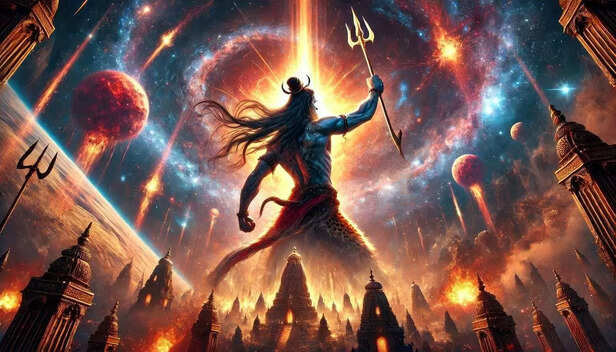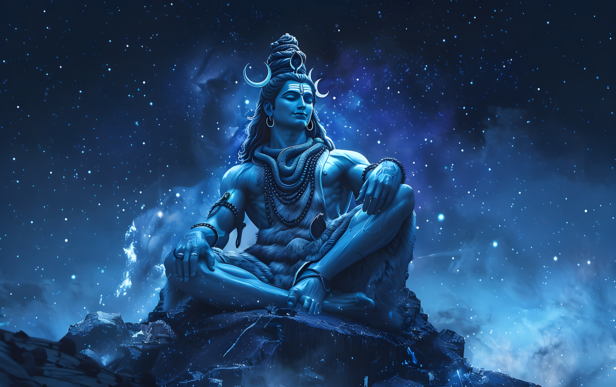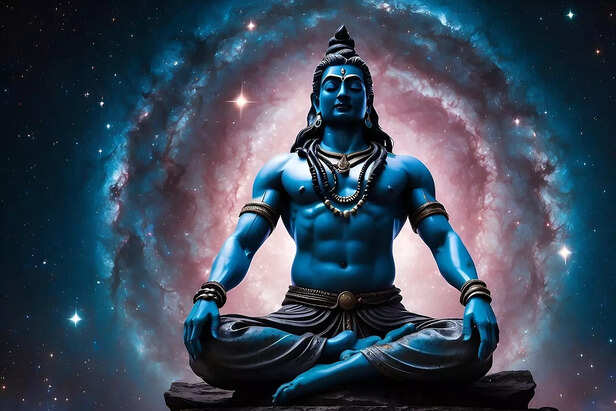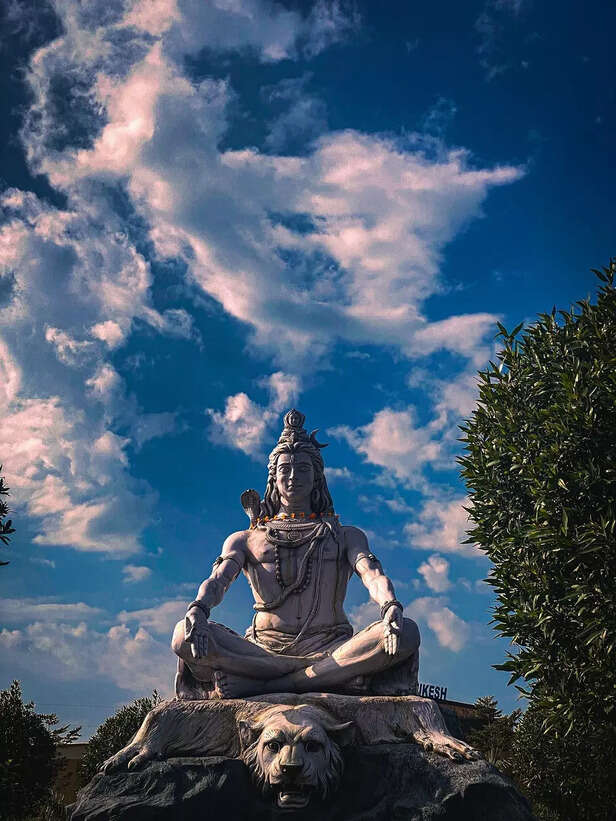Lord Shiva’s Tandava: The Dance That Created the Universe
Siddhartha Gupta | Thu, 19 Jun 2025
The article explores the mystical and philosophical depth behind Lord Shiva’s Tandava, the cosmic dance that symbolizes creation, preservation, and destruction. It dives into ancient stories — from Shiva’s grief-driven Rudra Tandava after Sati’s death to the blissful Ananda Tandava in Chidambaram — revealing how this dance is far more than myth; it’s the rhythm of the universe itself.Through detailed symbolism, scriptural references, and even scientific connections — like the Nataraja statue at CERN — the piece highlights how Tandava bridges mythology and quantum theory. The article also uncovers the dance’s modern relevance, showing how cycles of chaos and rebirth in our lives mirror Shiva’s movements.
( Image credit : Freepik )
Photo:
Imagine a dance so powerful that it holds the rhythm of creation, destruction, and everything in between. Not a metaphor, but a cosmic truth — alive in the heart of Indian mythology.
That’s Tandava.
Lord Shiva, the supreme ascetic and the cosmic dancer, isn’t just a figure wrapped in ash and silence. He is the storm and the stillness. And when he dances — the world listens, burns, breathes, and begins again.
This isn’t just mythology. This is philosophy wrapped in movement, a story that has shaped temples, scriptures, and the very concept of time.

Tandava isn’t a folk performance or classical item. It’s not meant for applause. It’s the rhythm of the universe itself.
In Sanskrit, ‘Tandava’ means a vigorous dance. But this isn’t ordinary motion — it's a cosmic phenomenon. According to the scriptures, Shiva performs Tandava at the end and beginning of every cosmic cycle — a process of Srishti (creation), Sthiti (preservation), Samhara (destruction), Tirobhava (illusion), and Anugraha (grace).
Each step carries the weight of galaxies, each gesture creates or collapses dimensions. Think of Tandava as the Big Bang — only spiritual.

The most iconic depiction of Tandava is through Lord Nataraja — Shiva in his dancing form, surrounded by a ring of fire, one foot planted on the demon of ignorance (Apasmara), and the other raised in freedom.
What’s fascinating is how this image isn't just symbolic — it has inspired artists, scientists, and even physicists. The famous CERN laboratory in Switzerland has a statue of Nataraja at its entrance. Why? Because Shiva’s dance mirrors the subatomic dance of particles.
Creation and destruction aren’t moral; they are necessary — and Shiva represents that duality.

There isn’t one origin story — there are many. And each is more potent than the last.
1. The Dance of Grief: After Sati’s Death
One of the most emotional stories comes after the tragic death of Sati, Shiva’s first consort. When she immolated herself in protest of her father Daksha's insult to Shiva, the god of destruction didn’t hold back.
He picked up her burnt body and danced across the universe in grief and fury.
With each stomp, mountains shattered, oceans roared, and time began to fall apart. This was the Rudra Tandava — raw, fierce, and grief-laden. Vishnu had to intervene, cutting Sati’s body into 51 pieces (which became the Shakti Peeths) to calm Shiva.
Even gods trembled. This wasn’t a tantrum — it was cosmic mourning.
2. The Dance of Joy: Ananda Tandava
Then there’s the opposite — the Ananda Tandava, the dance of bliss. This is not violent, but ecstatic. It’s performed not in anger, but in transcendence — in Chidambaram, the sacred space of consciousness.
Here, Shiva dances to celebrate life and liberation, surrounded by gods, sages, and the universe itself. The sound of the damaru (his hourglass drum) sets the rhythm, while his hair sways like the rivers of time.
It’s said that Brahma, Vishnu, and Saraswati play music while he dances — a celestial orchestra.

Tandava isn’t chaotic. It’s deeply symbolic. Scholars and dancers have studied its 108 poses — and each has spiritual significance.
This dance isn’t just visual — it’s a coded message from the divine.

It may sound surprising, but Nataraja is often cited in discussions of quantum physics and particle theory.
The image of Shiva dancing within a circle of fire represents subatomic motion — where destruction and creation are happening simultaneously. Fritjof Capra, in his book The Tao of Physics, described Tandava as an ancient metaphor for modern physics.
CERN didn’t place Nataraja outside its particle accelerator just for decoration — they saw him as the cosmic metaphor for energy transformation and balance.
In a way, Tandava is both Shiva’s poetry and the universe’s physics.
We may not see Shiva dancing in the clouds, but Tandava continues — in the rise and fall of civilizations, in the heartbreaks we survive, in the moments we feel both broken and reborn.

Perhaps no place embodies the Tandava like the Chidambaram Temple in Tamil Nadu.
Inside this ancient structure is the Chidambara Rahasya — a curtain hiding empty space, representing the formless aspect of Shiva.
Here, Nataraja doesn’t just dance — he liberates. Priests perform rituals to the rhythm of his dance, and devotees experience his grace not through statues, but through energy.
It’s said, those who can hear the silence behind the curtain are truly free.
Tandava isn’t just about Shiva. It’s about you. Your journey. Your ability to destroy what no longer serves you — and dance anyway.
We all carry storms inside us. We all have something to burn, to cry over, and to celebrate. And in every collapse, there is a heartbeat of a new beginning.
Shiva teaches us that the most powerful dance is the one that transforms you — not with perfection, but with passion.
So, the next time life breaks you, remember: even Shiva dances through destruction.
And from that dance, the universe begins again.
Unlock insightful tips and inspiration on personal growth, productivity, and well-being. Stay motivated and updated with the latest at My Life XP
That’s Tandava.
Lord Shiva, the supreme ascetic and the cosmic dancer, isn’t just a figure wrapped in ash and silence. He is the storm and the stillness. And when he dances — the world listens, burns, breathes, and begins again.
This isn’t just mythology. This is philosophy wrapped in movement, a story that has shaped temples, scriptures, and the very concept of time.
What is Tandava? Not Just a Dance

Rhythm of universe
( Image credit : Freepik )
Tandava isn’t a folk performance or classical item. It’s not meant for applause. It’s the rhythm of the universe itself.
In Sanskrit, ‘Tandava’ means a vigorous dance. But this isn’t ordinary motion — it's a cosmic phenomenon. According to the scriptures, Shiva performs Tandava at the end and beginning of every cosmic cycle — a process of Srishti (creation), Sthiti (preservation), Samhara (destruction), Tirobhava (illusion), and Anugraha (grace).
Each step carries the weight of galaxies, each gesture creates or collapses dimensions. Think of Tandava as the Big Bang — only spiritual.
Nataraja : The Form That Changed Art and Science

Lord Shiva Tandava
( Image credit : Freepik )
The most iconic depiction of Tandava is through Lord Nataraja — Shiva in his dancing form, surrounded by a ring of fire, one foot planted on the demon of ignorance (Apasmara), and the other raised in freedom.
What’s fascinating is how this image isn't just symbolic — it has inspired artists, scientists, and even physicists. The famous CERN laboratory in Switzerland has a statue of Nataraja at its entrance. Why? Because Shiva’s dance mirrors the subatomic dance of particles.
Creation and destruction aren’t moral; they are necessary — and Shiva represents that duality.
The Birth of Tandava: Stories that Breathe Fire

Shiva Tandava
( Image credit : Freepik )
There isn’t one origin story — there are many. And each is more potent than the last.
1. The Dance of Grief: After Sati’s Death
He picked up her burnt body and danced across the universe in grief and fury.
With each stomp, mountains shattered, oceans roared, and time began to fall apart. This was the Rudra Tandava — raw, fierce, and grief-laden. Vishnu had to intervene, cutting Sati’s body into 51 pieces (which became the Shakti Peeths) to calm Shiva.
Even gods trembled. This wasn’t a tantrum — it was cosmic mourning.
2. The Dance of Joy: Ananda Tandava
Here, Shiva dances to celebrate life and liberation, surrounded by gods, sages, and the universe itself. The sound of the damaru (his hourglass drum) sets the rhythm, while his hair sways like the rivers of time.
It’s said that Brahma, Vishnu, and Saraswati play music while he dances — a celestial orchestra.
Every Gesture Has Meaning: The Hidden Code of Tandava

Meaning of Shiva Tandava Dance
( Image credit : Freepik )
Tandava isn’t chaotic. It’s deeply symbolic. Scholars and dancers have studied its 108 poses — and each has spiritual significance.
- Raised right hand (Abhaya Mudra) — protection
- Left hand across the body — grace
- Foot crushing the demon Apasmara — victory over ignorance
- Ring of fire — cycle of time and samsara
- Damaru in hand — the sound of creation (Om)
This dance isn’t just visual — it’s a coded message from the divine.
Science Meets Spirituality: Why Physicists Love Nataraja

MAHADEVA
( Image credit : Freepik )
It may sound surprising, but Nataraja is often cited in discussions of quantum physics and particle theory.
The image of Shiva dancing within a circle of fire represents subatomic motion — where destruction and creation are happening simultaneously. Fritjof Capra, in his book The Tao of Physics, described Tandava as an ancient metaphor for modern physics.
CERN didn’t place Nataraja outside its particle accelerator just for decoration — they saw him as the cosmic metaphor for energy transformation and balance.
In a way, Tandava is both Shiva’s poetry and the universe’s physics.
Tandava in Today’s World: Why It Still Matters
- When you go through pain and come out wiser, that’s Tandava.
- When society collapses, only to rebuild stronger — that’s Tandava.
- It teaches us that destruction isn’t always bad. Sometimes, it’s necessary to make space for something better.
Chidambaram: The Temple That Holds Silence

MAHADEVA
( Image credit : Freepik )
Perhaps no place embodies the Tandava like the Chidambaram Temple in Tamil Nadu.
Inside this ancient structure is the Chidambara Rahasya — a curtain hiding empty space, representing the formless aspect of Shiva.
Here, Nataraja doesn’t just dance — he liberates. Priests perform rituals to the rhythm of his dance, and devotees experience his grace not through statues, but through energy.
It’s said, those who can hear the silence behind the curtain are truly free.
When You Dance Like Shiva
We all carry storms inside us. We all have something to burn, to cry over, and to celebrate. And in every collapse, there is a heartbeat of a new beginning.
Shiva teaches us that the most powerful dance is the one that transforms you — not with perfection, but with passion.
So, the next time life breaks you, remember: even Shiva dances through destruction.
And from that dance, the universe begins again.
Unlock insightful tips and inspiration on personal growth, productivity, and well-being. Stay motivated and updated with the latest at My Life XP










